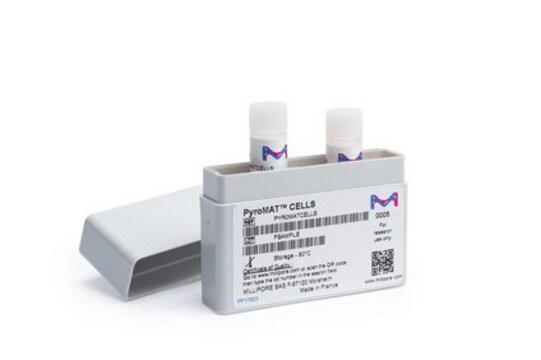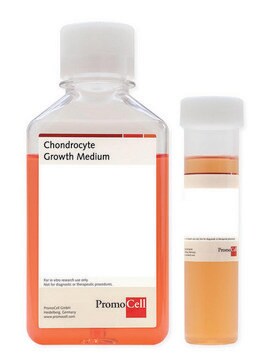408-05A
Human Fibroblast-Like Synoviocytes: HFLS, adult
Sinónimos:
HFLS cells
About This Item
Productos recomendados
origen biológico
human synovial tissues (normal)
Nivel de calidad
envase
pkg of 500,000 cells
fabricante / nombre comercial
Cell Applications, Inc
modo de crecimiento
Adherent
cariotipo
2n = 46
morfología
Fibroblast-like
técnicas
cell culture | mammalian: suitable
enfermedades relevantes
arthritis
Condiciones de envío
dry ice
temp. de almacenamiento
−196°C
Descripción general
Normal HFLS provide an excellent cellular model for studying the normal and pathological physiology of synoviocytes and development of joint diseases.
Normal HFLS have been used in numerous research studies to:
- Study changes in gene expression in synoviocytes stimulated with TNFα (Suggiyama, 2002)
- Demonstrate that TNF-like weak inducer of apoptosis (TWEAK) contributes to joint inflammation by inducing chemokines such as MIP-1β (CCL-4), lymphotactin (XCL-1), IFN-γ-inducible protein 10 (IP-10) (CXCL-10), MCP-1 (CCL-2), and RANTES (CCL-5), as well as the matrix metalloprotease-9, suggesting TWEAK as a new therapeutic target (Perper, 2006)
- Demonstrate the role of miR-124a in arthritis pathogenesis (Nakamachi, 2009)
- Show that C/EBPβ regulates expression of metalloproteinases and ADAMTS family members in synoviocytes stimulated with IL-1β (Tsushima, 2012); and that HMW-HA suppressed ADAMTS4 mRNA and protein expression via CD44, p38 MAPK and JNK pathways (Kataoka, 2013)
- Evaluate the anti-inflammatory and antirheumatic activity of various compounds, such as NF-κB inhibitors (Wen, 2006), AGIX-4207 (Kunsch, 2005), HA–methotrexate conjugates (Homma, 2009) and bucillamine (Oki, 2009)
- Show that reactive arthritis triggered by chlamydial infection is mediated by TLR2 induced IL-6 production in synoviocytes (Konomi, 2009); and investigate the mechanisms of arthritis-like syndrome in patients infected with chikungunya (CHIK) virus (Xu, 2013)
- Suggest that only leukocyte-poor, RBC-free platelet-rich plasma should be used in clinical orthopaedics because leukocytes and RBCs cause synoviocyte death and proinflammatory mediator production (Brown, 2014)
- Identify that cartilage link protein and MAGP2 can be used as specific markers to distinguish chondrocytes and synovial cells (Rapko, 2007, 2010)
- Create, along with human dermal fibroblasts, induced pluripotent stem cells (iPSC) by using the now classic “Yamanaka cocktail”, the discovery for which Dr. Shinya Yamanaka was awarded the Nobel Prize in 2012 (Takahashi, 2007)
Additionally, in parallel with HFLS isolated from joints of patients with rheumatoid arthritis, normal HFLS were used to:
- Identify causing agents (such as uric acid crystals or platelet microparticles) and study the immunopathological mechanisms and signal transduction pathways leading to joint inflammation in rheumatoid arthritis (Chen, 2011a; Hsu, 2012; Mathieu, 2008; Tsuji, 2012), and to demonstrate the role of estrogen signaling in increasing inflammation (Galal, 2008)
- Investigate anti-inflammatory properties of herbal compound Sinomenine suggested for rheumatoid arthritis treatment (Chen, 2011b)
- Study the effects of extracellular matrix composition on cell attachment and migration relevant to T-cell function in inflamed tissues (Evanko, 2012)
Finally, all three types of HFLS (normal, RA and OA) were used to investigate the role of human endogenous retroviruses (HERVs) in development of rheumatoid arthritis, and suggest that activated expression of different forms of HERV contribute to development of rheumatoid arthritis symptoms by different mechanisms (Freimanis, 2010).
Origen línea celular
Aplicación
Componentes
Nota de preparación
- 2nd passage, >500,000 cells in Basal Medium containing 10% FBS & 10% DMSO
- Can be cultured at least 5 doublings
Rutina de subcultivo
Cláusula de descargo de responsabilidad
Código de clase de almacenamiento
11 - Combustible Solids
Clase de riesgo para el agua (WGK)
WGK 3
Punto de inflamabilidad (°F)
Not applicable
Punto de inflamabilidad (°C)
Not applicable
Elija entre una de las versiones más recientes:
Certificados de análisis (COA)
Lo sentimos, en este momento no disponemos de COAs para este producto en línea.
Si necesita más asistencia, póngase en contacto con Atención al cliente
¿Ya tiene este producto?
Encuentre la documentación para los productos que ha comprado recientemente en la Biblioteca de documentos.
Protocolos
Store the cryovials in a liquid nitrogen storage tank immediately upon arrival.
Nuestro equipo de científicos tiene experiencia en todas las áreas de investigación: Ciencias de la vida, Ciencia de los materiales, Síntesis química, Cromatografía, Analítica y muchas otras.
Póngase en contacto con el Servicio técnico


